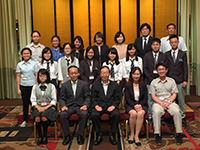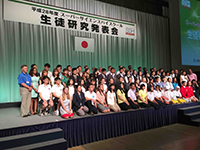The fair, put together by MEXT (Ministry of Education, Culture, Sports, Science and Technology) and supported by JST, is an annual gathering of high school science departments from all over Japan and around the world including participants from China, Germany, Thailand, Singapore, Taiwan, Philippines, USA, Malaysia, South Korea and India.
In particular, as I pondered this serious case of enthusiasm, I found myself drawn to the Meikei High School booth, where I found a young man eager to show off his research into the self-reinforcing solitary wave known as the Soliton. Inspired by his memories of the horrifying power of the Tsunami following the 2011 Tokoku Earthquake, what he presented to me was research he had been working on since he had been in primary school.
The Soliton wave, he told me, is so destructive because it self-propagates at a constant velocity, growing larger and larger until it becomes the devastating force he watched on television wiping out everything in its path. But if he could discover the way it forms, he said, perhaps too he could discover a way of stopping it. And in a poster his younger brother had helped him design, he outlined an underwater mesh device made of concrete which he theorised might be employed to disperse the Soliton wave’s energy before it reached its most devastating heights.
Of course, there were also so many questions unanswered. How much would it cost? How practical is it? How could such a thing even be constructed? But I also had to conclude that those questions are not for a fair like this. Instead, the Super Science High School Fair is for nurturing the most important resource of science – the enthusiasm and curiosity of young minds.
All around the exhibition halls in Kobe there were many more examples of that enthusiasm found at the Meikei High School booth. In all there were over 5000 students from some 202 schools from all over Japan, plus invitees from 10 other countries/region as well. And in the opening ceremony, famed Japanese scientist Dr. Sumio IIJIMA (Tenured professor, Graduate School of Science and Technology, Meijo University) shared his memories of his own youthful enthusiasm which drove him, against the odds, to discovering the carbon nanotube.
Following the opening ceremony the first floor, which was dedicated to Maths and Physics, and the second floor given over to Chemistry and Biology were soon flooded with members of the public as each high school booth presented their research projects to the visitors.
And it soon became apparent to me that the presentations were mostly so interesting because most of the themes on show were driven purely from curiosity.
One research project done by the Miyagi Prefectural Sendai First High School caught my eye with their research titled: “To increase the number of women who work as administrators or researchers”.
While the research topic was more about social science rather than pure science, it still showed clearly how scientific methods can shed light on important issues in Japanese society.
The fair also highlighted 6 projects selected by judges from which one was awarded the “Ministry of MEXT Award”, while two others were given the “JST Award”.
Those 6 projects were as follows:
(1) “Adding winglets to turbines: A new design” by Hyogo Prefectural Kakogawa Higashi Senior High School (JST Award)
- In order to improve the design of micro wind turbines, various blade designs were tested. Especially, a blade shape based on a bird’s winglet was examined. It was determined that the bird’s wing design generated about twice as much power as a blade with no winglet.
(2) “Let’s transform Forest Remaining Wood into Pink Dye and Energy” by Tokyo Metropolitan Tama High School of Science and Technology
- The Japanese cedar called “Sambu-sugi” in Sanmu city has been facing severe problems caused by an illness which kills the trees. Investigating ways the wood can be used after the death of the trees, the students attempted to dye clothes pink by using wood chips of Sambu-sugi. Secondly, the students made methane gas from the wood chips by Phrolisis technology.
(3) “Where is the difference between concentrated sulfuric acid and diluted sulfuric acid” by Yamanashi Prefectural Nirasaki High School
- Investigating the difference between sulfuric acid and diluted sulfuric acid, the students reviewed the properties of sulfuric acid to distinguish the differences. Testing their five properties, they determined the borderline between them as 13 mol/L.
(4) “The Memory and the Regeneration of Planarians” by Hyogo Prefectural Kobe High School (JST Award)
- Conducting a series of experiments to confirm if a Planarian’s memory could survive through the regeneration of a new head, the students’ results did not fully support the hypothesis, but proved nonetheless that both initial learning and regeneration have an influence on the repeated learning process.
(5) “Isolation of Oil-degrading Micro-organisms and Application to Feed” by Yokohama Science Frontier High School
- Since the 1970’s, feeding yeast with petroleum hasn’t spread in Japan due to the hazards associated with petroleum. The purpose of this study was to make feed by using waste oils and oil-degrading micro-organisms. In this study, the students isolated two types of micro-organisms with an oil-degrading ability.
(6) “Effect of Shape on Flight Performance of a Horizontal Axis Rotation Object-Application for Wind Turbine Generator” by Fukuoka Prefectural Kasumigaoka High School (Ministry of MEXT Award)
- When you throw an X-gyro with a spin, it flies at a long distance. The students working on this research project hypothesized this could be improved through two factors – Wind Lens and Dimples. Through their experiments, the students succeeded in decreasing air resistance. Furthermore, they succeeded in inventing a new kind of wind turbine generator.
Additionally, alongside the Japanese high schools represented at the fair, there were also foreign high schools from 10 other countries/region in attendance as well. Those schools invited by JST were the following:
Albert-Schweitzer-Gymnasium, Erfurt (Germany), Huayang High School (China), Zhengzhou Foreign Language High School (China), Zhengzhou No.11 High School (China), Georg-Cantor-Gymnasium, Halle (Germany), Marion-Donhoff-Gymnasium, Nienburg (Germany), Soongeui Girls’ High School (Korea), Suji High School (Korea), Bishop Cotton Boys’ School (India), BLUEBELLS school International (India), HIDAYAH ISLAMIC SCONDARY SCHOOL (Malaysia), St. Mary’s School (India), PSHS-Ilocos Region Campus (Philippines), PSHS-SOCCKSARGEEN Region Campus (Philippines), PSHS-Southern Mindanao Campus (Philippines), PSHS-Central Mindanao Campus (Philippines), PSHS-Cordillera Region Campus (Philippines), PSHS-Western Visayas Campus (Philippines),Phitsanulok Pittayakom School (Thailand), Samsenwittayalai School (Thailand), National Junior College (Singapore), NUS high school of maths and science (Singapore), Raffles Girls’ School (Secondary) (Singapore), Yupparaj Wittayalai School (Thailand) Rockdale Magnet School for Science and Technology (U.S.A),National Chaghua Senior High School (Taiwan) Taipei JingMei Girl’s High School (Taiwan), The Affiliated Industrial Vocational High School of NCUE(Taiwan),National Changhua Senior High School (Taiwan).


(JST Singapore Office)